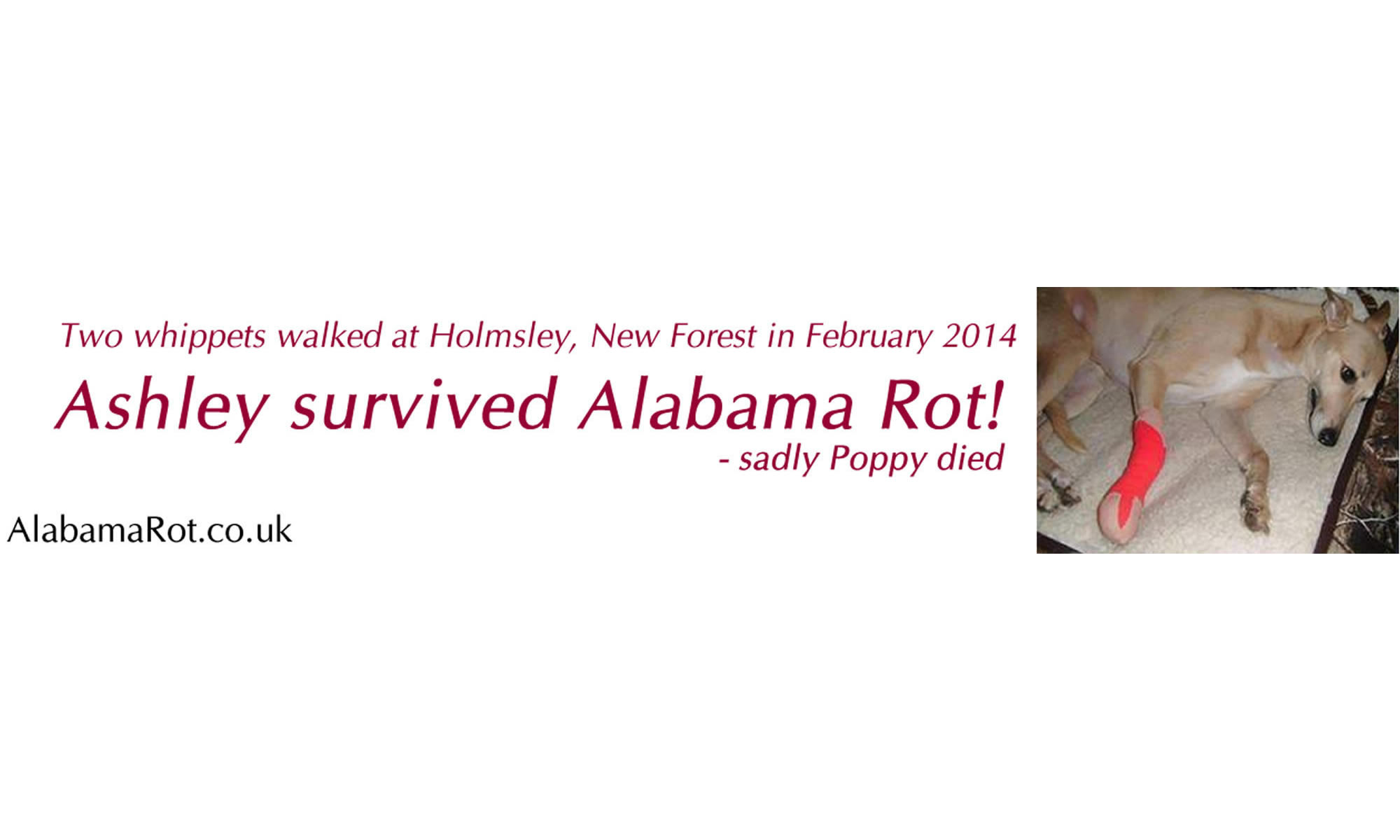 On 14th April 2014 the Royal Veterinary College (RVC) made a podcast with Dr Rosanne Jepson (member of Renal Replacement Therapy team at Queen Mothers Hospital for Animals) and Shailen Jasani of RVC.
On 14th April 2014 the Royal Veterinary College (RVC) made a podcast with Dr Rosanne Jepson (member of Renal Replacement Therapy team at Queen Mothers Hospital for Animals) and Shailen Jasani of RVC.
The friendly podcast is targeted at vets – not the general public – so I’ve included links to several terms, hopefully to make the podcast easier to understand.
Listen to the 43 minute Podcast
I have summarised the podcast:

1m The term ‘Alabama Rot’ was used in the mid 1980s when Greyhounds (and a Great Dane in 1990s) were dying of kidney disease at the Alabama Racetrack in USA. The terms ‘Alabama Rot (AC) like-syndrome’ or ‘New Forest Syndrome’ are used for UK dogs with similar symptoms to the greyhounds in Alabama.
2m Alabama Rot aka New Forest Syndrome aka idiopathic Cutaneous and Renal Glomerular Vasculopathy (CRGV) typically causes skin lesions AND kidneys failure in dogs

3m What is the cause of Alabama Rot? An early hypothesis was that a bacterial infection was the cause. However there has been no confirmation in any case of toxins being produced by E.Coli, Shigella, or Campylobacter bacteria.
4m – 11m Many different dog breeds have had Acute Kidney Injury (AKI) and Alabama Rot in the UK since November 2012 to April 2012 and then from October 2013 to April 2014. Originally in the New Forest, it has now spread widely in England.
The Animal Health Trust have a public questionnaire on Alabama Rot distribution (link deleted 18/10/16).
Initial cases where in the New Forest but now the distribution is UK-wide. Forestry Commission tables are updated fortnightly. [last table was 21st July 2014]
David Walker of Anderson Moores near Winchester has been very proactive in disseminating info and campaigning for more research on the cause of Alabama Rot. His blog is updated regularly http://www.andersonmoores.com/vet/news. [best source of info on Alabama Rot]
There is no known association of raw foods or other diet or treat is linked to Alabama Rot.
The triggers of Alabama Rot may not be present when diagnosis is made or at postmortem when the dog dies.
12m Skin lesions range from small erythematosus areas, ulcerative or erosive lesions below the elbow or stifle (knee). Lesions are solitary or multiple and can affect the entire limb, ventrum (belly or abdomen) or muzzle (nose, mouth, lip).
13m – 15m In dogs, these variable skin lesions may develop into acute kidney injury (AKI) within 2-7 days. However not all skin lesions or AKI are due to Alabama Rot. But if the dog has symptoms of BOTH skin lesions AND AKI, then these symptoms are novel to Alabama Rot.
16m At 14th April 2014, 31 dogs were confirmed with renal histopathology ie at post mortem, a further 20 dogs were unconfirmed (without renal histopath). Other cases may have occurred but not have been reported.
17m David Walker, Rosanne Jepson et al are working on publishing a paper [in the Veterinary Record].
18m – 20m Skin lesions may need antibiotics against Leptospirosis however Leptospirosis has not been found in any case (after testing using fluorescent in situ hybridisation of kidneys). No surgery is performed on skin lesions except for diagnostic biopsy.
21 – 22m Some cases have had Thrombocytopenia (decreased blood platelets).
Vets should make sure kidneys are adequately perfused and the dog is not dehydrated. Check urine input/output using urinary catheter for oliguric / anuria.
23m Acute Kidney Injury: Test for creatinine serially to detect increases, urinary cast and baseline renal values. Repeat blood and urine testing every 24hrs.
24 – 26m If above treatments don’t succeed try Dialysis (Renal replacement therapy) – only available at Royal Vet College in UK apart from some hospitals with Peritoneal Dialysis.
With 2 cases, renal replacement therapy (RRT) was tried for 7 & 10 days at Royal Vet College (RVC) to stabilise urine production and provide correct electrolyte balance. But would dogs have survived if put on a longer course of RRT?
27m In USA no known cases of dogs with Alabama Rot going on with RRT for several months or longer. University of California at Davis in USA can provide this facility. Some dogs might recover with longer term treatment, but this has not been tried in the UK.
28m RVC send renal biopsies to USA (light / electron microscopy & Immunofluorescence). In future, they may consider renal biopsies before dog dies (ante mortem)
29m A 3rd case was treated at RVC with Plasmapheresis (plasma exchange – plasma taken out of blood and exchanged for clean plasma) – was performed on one unconfirmed dog (histopath on skin lessions was positive, no test on kidney done) with suspected Alabama Rot dog [‘Alba’ – owner Rebecca McGee]. Good News! This dog survived.
30m Rosanne Jepson makes two possible hypothesis about treatment: Alternative hypothesis H1 “Some cases of Alabama Rot can be successfully treated with Plasmapheresis (Plasma Exchange).” Null hypothesis H0 “Some cases of Alabama Rot CANNOT be successfully treated with Plasmapheresis (Plasma Exchange).”
RVC are the only organisation in UK that has the machine for Renal Replacement Therapy dialysis and / or Plasmapheresis.
Currently 80% dogs with Alabama Rot are dying according to David Walker at Anderson Moores Vets.
[Do vets / Anderson Moores Vets need to be referring more dogs with Alabama Rot to the Royal Veterinary College? – CGS]
30m The rationale for using Plasmapheresis to treat Alabama Rot comes from human medicine. There are a number of conditions where very similar histophathological findings have been identified in humans: Thrombotic Microangiopathy which is related EITHER to:-
– Hemolytic Uremic Syndrome (HUS)
– Atypical Hemolytic Uremic Syndrome (aHUS)
– Thrombotic Thrombocytopenic Purpura (TTP)
31 – 33m “Also more expensive agents out there which would be cost prohibitive to veterinary patients” [Is this Eculizumab?? – CGS]
34m Plasmaphoresis should be considered to treat dogs with Alabama Rot for abnormalities (‘derangements’) in compliment activation or with dogs of a specific genetic disposition. With Plasmaphoresis, vascular inflammatory mediators might be removed in dogs with Alabama Rot.
Since RVC have had only one case (n=1), RVC cannot say yet that there is no evidence for Plasmaphoresis being the therapy for Alabama Rot.
At least, get baseline renal values if a dog gets skin lessions.
The benefit of not walking a dog in a particular area of the New Forest or elsewhere remains unclear, especially areas in which only one dog (n=1) has been affected.
35 – 38m In summary, the vet should get baseline renal values, act quickly if deteriorating. If lession is progressive, get renal baseline values. As per grapes / raisins poisoning, intra-venous (IV) fluid replacement therapy might be considered by the vet.
39m AKI AND skin lessions is unique to Alabama Rot.
40m Difficult to say whether to advise limiting walks in an area, if only 1 case.
END
